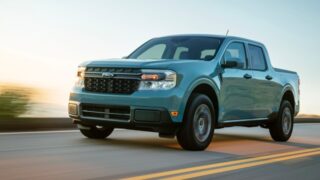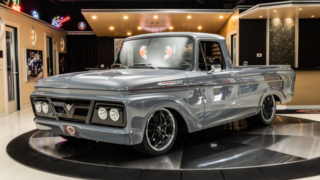Brake Tech for early model Ford F100 Pickup trucks through 1964
By: Skip Porterfield
While much has been written on the later model Ford trucks with twin I-beam front ends, there has not been much available for the earlier trucks with straight axles. As a result, I would like to submit the following information intended as a general guide for upgrading the brake systems of the earlier model F-100 Ford pickup truck with straight axles from 1957 to 1964.
When you start looking at your old brakes, it is strongly recommended that the individual owner seriously take a close look at the entire system, including hard lines, rubber lines and cylinders for decay and corrosion. After more than 30 or more years, no matter how good it looks, it probably isn’t as good as it seems. The steel lines corrode and the rubber swells shut. Also, standard DOT brake fluid absorbs moisture and causes internal parts to rust. Check it closely. I suggest that after rebuilding your brakes and flushing out your brake system you consider using at least the synthetic DOT 4 fluid. Even better is the more expensive (in the short run) Silicon DOT 5 fluid which does not absorb moisture and corrode.
If you are planning a total replacement of the system (which you should), there are some things to consider. Drum brakes on the front of your truck are not the most optimum choice unless you are going for a complete restoration. Several companies now offer disk brake conversions for older trucks and cars, and from a safety point, this is the obvious choice for your truck. A disk brake conversion of this kind for the front of your truck should run in the neighborhood of $400.00 including new rubber lines. I call that cheap insurance.
Another special case is the 1963 F-100 where Ford used what is called a half-cylinder on the front drums and this part is no longer available. They can, however, be sent to a brake specialty shop to be bored and sleeved with a stainless steel liner, but you are still stuck with 1960’s technology and the cost will approach that of the disk brake kit. Or, if you can find a donor, upgrade to the 1964 backing plate and wheel cylinders.
Rear drums can be re-built for around $100.00 with all new parts. I am going to list some part numbers later, but be sure to keep all the old hardware, i.e. springs, arms, etc. until you can match them with the new parts. In fact, later model rear drums (through 1973) can be fitted to the earlier Ford 9" rear end by using the entire rear brake assembly (backing plate, drums, etc.) or companies such as Bendix still offer original parts for the older trucks. These later model rear brakes from a truck with the 9" rear end are a direct bolt on. The difference is that the newer backing plates are recessed to accommodate the wider drums and shoes, but everything else is the same. The original emergency brake cables will plug directly into the new backing plates.
When (and I strongly suggest that you consider this option) you replace your steel lines, get a standard 20′ coil of 3/16 brake line available at almost any auto parts store for about $10.00 to $15.00. You can buy smaller pre-made lengths, but they won’t always fit your situation. Remove your old lines carefully and bend the new pieces to match the old ones. Brake lines require a 45 degree reverse female flare (a double flare) and this process requires a special tool. Some auto parts like Pep Boys loan tools, so ask around before you buy a tool like this one. Do not single flare these connections or use a standard flaring too. (It really isn’t necessary to put the big coils in the line near the master cylinder so don’t waste your tubing. You just need enough extra length to make sure you can hook up the lines.) DO NOT flare your lines until you have trial fitted them and leave some extra length on each end in case you ruin a flare. Make sure you install the brake flare fitting on the line before you flare the tube.
When you are ready to start the project, make sure that you have all the parts and tools you are going to need ready before you start work on your truck. * Please note: if you are considering a disk brake conversion, you will have to custom bend new lines for the front brakes, and you will have to include enough line for the rear brake line to include a proportioning valve in the system. See Part 2 before going on.
I have provided a list of part numbers later in this article. The following steps are what I have found to be the quickest way to complete your upgrade.
- Remove all the old steel and rubber brake lines from your truck.
- Bend your new brake lines and trial fit them to your truck. Install the 45 degree flare nuts and then flare the individual tubes. Make sure the threads are pointing out toward the end of the tube. This is tedious work and needs to be finished before you go on to the next step. Examine each flare carefully for cracks and for straightness. Disassemble and clean the rear brakes. I suggest taking the backing plates off the rear end and cleaning and painting them. This requires pulling the axle out of the housing. If you do this step, have the rear axle bearings and seals checked. It is much easier to replace them now than later and if you replace the rear bearings, make sure to pack the bearings before you put them back in the axle housing. Also, make a sketch or take a photo before you take things apart so you can put them back the way they came apart.
- Have the rear drums measured and turned. If they don’t have enough material left to safely turn, get new drums. I had mine sandblasted before I had them turned, them treated them with a rust preventative and painted them with hi-temp paint.
- Reassemble the rear brake components and adjust the brakes before you put fluid in the system. Remember, short shoe in front!!
- Repeat the process on the front brakes. If you are going back with drum brakes, make sure to clean the spindle, check for slop in the kingpins and bushings or ball joints, and reassemble the drum with new inner and outer bearings and a new grease seal.
- Reassemble the front brakes.
- Now is the time to install the new rubber brake hoses and hard lines.
Part 2
At this point I would like to discuss two options for the brake rebuild. Unless you are doing a restoration on your truck, you need to consider a dual master cylinder and the disk brake conversion I mentioned earlier.
First the master cylinder. I used a 1968-1970 Mustang big block dual master cylinder, but others will fit also. The Mustang unit bolts directly to the firewall on 1961 through 1964 trucks with no modifications and should also work on 1957-1960 trucks also as they use the same master cylinders. The power assisted unit also is a direct bolt in, but might require a different brake rod from the pedal. Ford made these rods in three different lengths and one of them should suit your application, but they can be custom fitted if necessary.
Second is the use of a disk brake kit. I used the one from ECI Components and was pleased with the fit and finish of the kit. While ECI included all the parts needed for the conversion including rotors, bearings, seals, spacers, hoses, calipers and bolts, the written instructions were poor and had no drawings or photos. Also, if you use disk brakes, you will need to include a proportioning valve on the new brake line going to the rear brakes. (I mounted mine on the firewall below the master cylinder to keep it out of the weather and for ease of adjustment.) There are other manufacturers out there with similar products.
The actual installation is straight forward and easy to complete. Just follow the directions, bend and flare your new lines, make sure the proportioning valve goes between the master cylinder and the rear brakes.
This is how I mounted the M/C, stop light switch, and proportioning valve on my truck.

General layout for new brake lines and dual master cylinder installation. Drawing courtesy of Hollibau from Slick 60’s.

New parts from Bendix available for the rear brakes are as follows:
- Shoes p/n R55
- Wheel cylinder p/n 33628 (the original narrow width units)
- Rear brake hose p/n 88240
- New spring and hardware kit p/n H-2540
- New star wheel adjuster kit p/n H-7144
A special note. Ford no longer has the metal rear axle seals (gaskets) available, so when you pull down your rear end, make sure to save these pieces. They seem to be available from specialty houses like Dennis Carpenter Reproductions and Sacramento Vintage Ford, but if you don’t have them or they are damaged, use silicone sealer on the backing plate to axle and on the axle flange to backing plate to keep leaks out.
Put in your new DOT 5 brake fluid and bleed and adjust your brakes. You will need to drive the truck to adjust the proportioning valve but it is an easy job. Just increase or decrease the pressure to the rear drums until the brakes don’t lock up when you stop hard.
This pretty much completes the tutorial on brake rebuilding. I hope each and every one of you that tries this upgrade has great success. Happy trucking and good stopping.
Skip Porterfield,
Slick 60’s F-100 Club
Skip4274@flash.net




